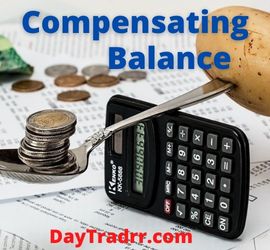What Is a Compensating Balance?
 A compensating balance is a form of collateral to be maintained with a lender that enables the borrower to secure a line of credit or installment loan. It is a minimum balance that effectively acts as collateral and thus compensates the lender for the risk of making the loan. Individual loans are less likely to require a compensating balance than corporate loans. The restricted balance cannot be used by the borrower. Also, it must be disclosed in the borrower’s notes to the financial accounts.
A compensating balance is a form of collateral to be maintained with a lender that enables the borrower to secure a line of credit or installment loan. It is a minimum balance that effectively acts as collateral and thus compensates the lender for the risk of making the loan. Individual loans are less likely to require a compensating balance than corporate loans. The restricted balance cannot be used by the borrower. Also, it must be disclosed in the borrower’s notes to the financial accounts.
A compensating balance successfully shifts the risk-reward balance in the lender’s favor. The lender earns interest on the entire amount of the loan but often charges the borrower a lower amount of interest. This is frequently offered by bankers as a way to offer a lower interest rate on loans made to existing bank customers. If the compensating balance falls below the statutory minimum, the interest rate on the loan will increase proportionally.
The compensating balance is also known as an offsetting balance. It is used to counterbalance the costs associated with extending and servicing the loan. The funds are required to remain in the non-interest-bearing account for the duration of the loan. As a result, the bank is free to use the money elsewhere. In this way, both the lender and the borrower find an advantage.
How a Compensating Balance Works
The borrower who agrees to hold a compensating balance promises the lender to maintain a minimum balance in an account. As a result, the bank is free to apply the compensating balance to other borrowers’ loans. The compensating balance is often expressed as a percentage of the entire loan amount. The money is usually kept in a deposit account, such as a checking or savings account, a certificate of deposit (CD), or another type of holding account.
The most frequent compensating balance structure is usually fairly basic. For example, there is a structure known as the 10 and 5 compensating balance. It requires the borrower to have a minimum of 10% of the extended line of credit in the account at the time the credit line is established. An extra 5% is required before drawing against the credit line. To illustrate, consider establishing a credit line of $200,000.00 US Dollars. The borrower’s account must have a minimum balance of $20,000.00 at the time of the credit line commitment (10%). The balance in the compensating account must be $30,000.00 (15%) in the event the credit line is accessed and drawn on.
For the borrower, the compensating balance is a mixed blessing. The loan generally will come at a lower rate of interest. However, the borrower must pay interest on the full amount of the loan, including the balance that may not be spent. A loan with a compensating balance may be extended to an individual or a company with a poor credit rating. Those applicants might otherwise be charged higher interest rates or be turned down for a loan. In return, the compensating balance cuts down on the risk to the lender. It allows them to recover part of the loan in cases of default.
How is a Compensating Balance Calculated?
There are two main ways of calculating a compensating balance. These are the average balance arrangement and the minimum fixed balance arrangement. The former tends to be used for lines of credit and the latter for installment loans.
- Average balance – The average balance arrangement requires a borrower to ensure that they maintain a minimum average balance over an agreed period. This is usually 30 days. The borrower, therefore, has the flexibility to use the whole line of credit for part of this period. They must, however, ensure that the money is repaid within the agreed time frame.
- Minimum fixed balance – The minimum fixed balance arrangement is exactly what it sounds like. The borrower must keep an agreed minimum balance with the lender at all times.
Accounting Rules on Compensating Balances
The dollar amount of a compensating balance can often be significant in corporate accounting. Accounting standards demand that compensating balances be recorded separately from cash balances in the borrowers’ financial statements. A significant amount is one that is large enough to sway a person reading a financial statement’s opinion. As a result, compensating balances are typically shown as restricted cash on financial statements. It is money that has been set aside for a specific purpose. Hence, it is unavailable for immediate or general business usage is referred to as restricted cash.
Why Do Borrowers Agree to a Compensating Balance?
Some borrowers may have no real choice. Some find it is a better deal. Others don’t bother to read the fine print.
- Building credit – Businesses have to build up a credit history, just like private individuals. And as with private individuals, this process takes time. What’s more, it can be set back as a result of both misguided decisions and unforeseen circumstances.
- Lower interest rates – Some borrowers may agree to leave a compensating balance because it provides them with a better overall deal. In short, even though they have to pay interest on the compensating balance, the lower interest rate they receive makes the deal worthwhile.
- Failure to read the fine print – Some borrowers may unintentionally consent to a compensatory balance. This can happen when they did not read or completely comprehend their loan arrangement. This emphasizes the need to thoroughly understand a contract before signing it. Get a professional to explain it to you if necessary.
Compensating Balance Example
Assume a furniture store needs a $100,000 line of credit (LOC) to manage its operating cash flow each month. The store plans to use the LOC to purchase inventory at the beginning of the month. Then, they will pay down the balance with money brought in by sales throughout the month. The bank agrees to charge a lower interest rate on the LOC if the clothing store maintains a $30,000 compensating balance. The bank then loans the restricted cash balance to other borrowers. As a result, the lender profits on the difference between the interest it earns and the lower rate of interest charged to the furniture store.
Cash Management
Once the LOC is in place, the furniture store needs to manage cash flow to minimize the interest expense it’s paying for use of the LOC. Assume, for example, the interest rate on the LOC is an annualized rate of 7% and the store starts the month with a $35,000 cash balance. The store estimates sales for the month to be $90,000, and $50,000 in inventory needs to be purchased to meet customer demand.
Since the store needs to maintain a minimum balance of $30,000, the owner borrows $50,000 from the LOC to purchase inventory. Most customers pay in cash or with a credit card, so the LOC can usually be paid off in the last week of the month. The store incurs an interest expense at a 7% annual rate on the $50,000, and the owner continues to borrow from the LOC at the beginning of each month to purchase inventory.
(Sources: law.cornell.edu, wise-geek.com, gocardless.com, & investopedia.com)
Up Next: What Is Joint Supply?
 Joint supply results when multiple products are derived from the same source and at the same expense. For example, when sheep are being raised for wool and meat.
Joint supply results when multiple products are derived from the same source and at the same expense. For example, when sheep are being raised for wool and meat.
A product or process that can provide two or more outputs is referred to as joint supply in economic terms. It usually occurs when two items are inextricably linked and produced from the same raw material or source. For example, cows can be used for milk, beef, and hide, from the livestock industry.
Sheep can be used to provide meat, milk, wool, and sheepskin. As the supply of one of the goods increases or decreases, the supply of the other good either increases or decreases at the same time. For example, the availability of dairy and beef products will increase as the supply of cows increases




